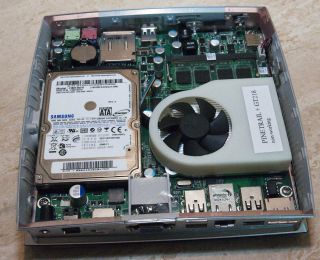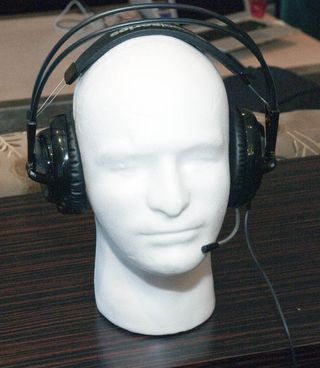
Zotac And SteelSeries
Ed.: This piece was submitted Saturday night. Unfortunately (or fortunately, depending on how you look at it), I was on a mad dash across the desert from SoCal to Vegas for a Sunday morning briefing with an unnamed company getting ready to launch an unnamed GPU. We'll have a story on that soon; in the interim, here's Loyd's CES wrap-up!
As Saturday at CES winds to a close, it’s worth taking a little time to digest this year’s consumer electronics lollapalooza. Before I do that, though, it’s worth checking out just a little more gear. Today, I met with mini-ITX specialists Zotac, gaming hardware purveyor SteelSeries, and took a look at OCZ's new SSD lineup.
Zotac: Small Really is Beautiful
Zotac has garnered a reputation for building feature-rich mini-ITX hardware. Most mini-ITX boards tend to be bare bones, but Zotac hasn’t shied away from offering interesting products for performance users. Here, "performance" may simply mean the ability to drive 1080p video while still running cool and quiet, but the company is also pushing solutions that you could arguably turn into a solid gaming system or high-capacity media server.
Take the new H55-ITX WiFi board, for example.

Sure, it’s got an H55 chipset, meaning you can drop in a Clarkdale-based CPU and use the integrated Intel HD Graphics GPU. But the board also has a full PCI Express x16 slot, which also means you could pop in a performance graphics card and built a compact (but potent) gaming system.
Zotac is also expanding into small form factor systems, adding its usual twists to create tiny systems that can offer rich visual experiences. Take, for example, the upcoming Pinetrail + GT218 Mag.
Stay On the Cutting Edge: Get the Tom's Hardware Newsletter
Join the experts who read Tom's Hardware for the inside track on enthusiast PC tech news — and have for over 25 years. We'll send breaking news and in-depth reviews of CPUs, GPUs, AI, maker hardware and more straight to your inbox.

What’s interesting is the GT218 label, which Zotac hinted really meant the use of a second-generation Ion graphics core from Nvidia; this on a Pinetrail (second-gen Atom) board. Performance is open to question though, since the Nvidia GPU would have to either work through the Intel DMI I/O or somehow cooperate with Intel’s integrated graphics core.
SteelSeries: Performance, not Appearance
At first blush, a company that established its initial reputation based on performance gaming surfaces (mouse pads) wouldn't seem to be the type of company that cares about audio performance. When SteelSeries shipped its first Siberia headset, I was impressed with how comfortable it was, but less impressed with its audio quality. Explosions and other loud effects would rock your world, but the headset was somehow boomy, with relatively muddy imaging, on musical content.
SteelSeries chief marketing officer Kim Rom promises that the Siberia V2 will change all that. The company is moving to a larger driver (50mm versus 40mm) with a rated frequency response of 10 Hz-28 kHz. He reasons that precise imaging is increasingly important in certain types of gaming. Rom also assured me that the second-gen headset would provide a much more pleasing musical experience.

The Siberia V2 also offers a more robust microphone, with better directional capabilities to minimize interference from room noise, which is essential in a busy LAN party environment. The boom retracts into the full size ear cups, and cabling has been beefed up for more durability.
The headset will be available in two different versions: one has standard analog mini-jacks (one for stereo output, the other for the microphone) and the other includes the company’s tiny USB sound card. The USB version ships with software that will make use of profiles for specific games.
SteelSeries will also be expanding its keyboard offerings as a result of its 2008 acquisition of keyboard maker Ideazon, but product plans haven’t been finalized yet. And, of course, it’ll continue to offer precision mouse pads with a variety of surfaces and gaming mice, including its World of Warcraft branded mouse for MMO players, complete with side mounted D-pad, 160 character macro support, and 15 total buttons.
-
Shadow703793 That Zotac looks really nice. I wonder how small of a case you can cram 5750 in to with out overheating.Reply
Imagine that board + a GTX260 in this: http://forums.bit-tech.net/showthread.php?t=178077
-
doomtomb The Zotac mini ITX interests me. I'm all about getting something powerful AND portable.Reply -
JohnnyLucky "unnamed company getting ready to launch an unnamed GPU"Reply
Normally we only have two companies to choose from. Is a third company about to make a debut? Inquiring minds want to know!!! -
Does this board has a HDTV tuner? If it is intended for HTPC type application, it lacks a PCIe 1X slot for the tuner card. Or better yet, have the tuner feature build in just like the WiFi.Reply
-
scryer_360 I hadn't even seen that Zotac board this year at CES! Good god, how could I miss it?Reply
I imagine it may not be the most overclockable, the I've been dying to build a new LAN party rig (I haven't attended one with my own computer since 2007). Micro-ATX boards were just ok, but this, this is huge! I mean, tiny!
Wonder if there is an ITX case that can hold a 5870... or the new Fermi stuff once it hits... -
scryer_360 Ugh, its only available in the UK so far.... wonder what the US retail cost will be?Reply -
drowned "The company is moving to a larger driver (50mm versus 40mm) with a rated frequency response of 10 Hz-28 kHz. He reasons that precise imaging is increasingly important in certain types of gaming."Reply
I refuse to deal with audio companies that even try to hint that 10-28 is better than 20-20 when that's the limits of perfect human hearing. Claiming otherwise shows they're out for money and not actual quality.
Most Popular



